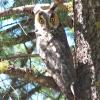It seems we got a little off track with the government involvement issues. But some interesting questions were asked at the beginning of this thread that I thought needed some further attention. Norseman asked about how much usable habitat there was between the Puget Sound and the Cascades in the winter. I am not very familiar with that area so I looked at the river drainages in the southern Cascades of Washington that I am familiar with. We have the Lewis, Kalama, Toutle, Cispus, Wind and the Cowlitz to name a few. I did a quick survey of the upper reaches of the rivers which included the smaller tributaries. I calculated the approximate square miles below the average elevation of 2500'. This being about the average lower level of continuous snow coverage most winters in this area. Most of the upper reaches of these rivers are in the GPNF or surrounded by closed Weyerhaeuser land. So there is little to no human population in these drainages in the winter. Most of the smaller creeks in these drainages are roadless, gated, or just plain inaccessible in the winter because you have to pass through higher elevations to access them. Some access is also limited because they are elk wintering areas. The habitat in these drainages ranges from 40 sq. mi. For the Kalama or Wind to 80 sq. mi. or more for the larger ones. As I said the elk winter in these areas, as well as the resident deer. In the area we do research in one of these drainages we've found 2 dozen elk that have died for whatever reason. From the evidence at each site the meat was utilized by various animals. The elk are still there. Their population is still healthy and this is only in a couple square miles. How many dead haven't we found? How many more are up and down the drainage that we don't know about? These drainages also contain herbaceous foods as well that aren't covered by snow. So the food stuffs are there and available, but we aren't in most of these drainages in the winter. So who's to say what is utilizing and moving up and down these drainages, with the occasional excursions into the higher elevations where you would find tracks? Maybe the trackways we do find are just single individuals moving from one of these drainages to the next. I'm certain that many of the winter sightings that are reported by residents happen when BF move down these same drainages into more human populated areas.
Of course, I know this may account for sasquatch in western Washington, but I know it doesn't account for them where snow lingers even in the valleys year round. We should see more of their tracks in snow if they are there. Who knows, maybe we would in more isolated drainages away from human population. Somebody mentioned above that elk herds are very good at covering tracks. I am in full agreement with this thought. Only elk tracks last for any length of time in elk country.



